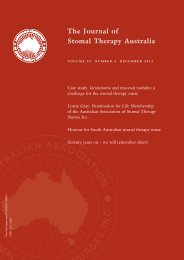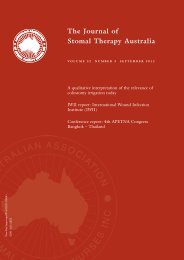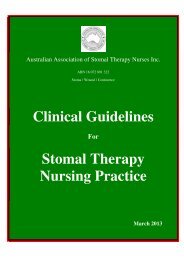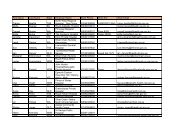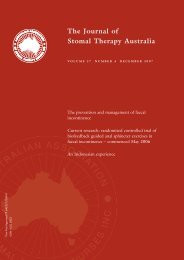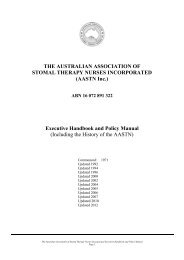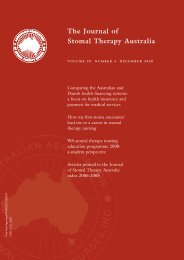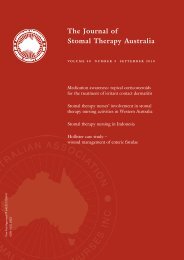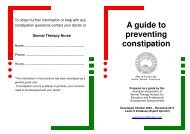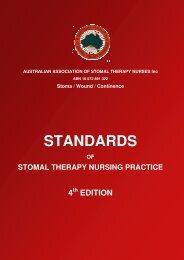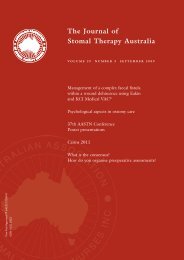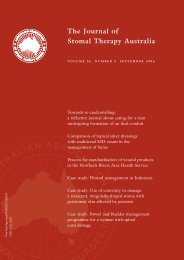JSTA December 2010 - Australian Association of Stomal Therapy ...
JSTA December 2010 - Australian Association of Stomal Therapy ...
JSTA December 2010 - Australian Association of Stomal Therapy ...
You also want an ePaper? Increase the reach of your titles
YUMPU automatically turns print PDFs into web optimized ePapers that Google loves.
Management<br />
Vacuum assisted closure (VAC ® ) negative pressure therapy<br />
(NPT) was used, despite recommended precautions on use with<br />
fragmented bone on view; however, conservative dressings<br />
were not able to cope with the high exudate requiring changing<br />
1/241 . High exudate predisposed the patient to further wound<br />
deterioration and breakdown2 . Additional issues were faecal<br />
incontinence constantly contaminating the wound bed due<br />
to close proximity to and involving the perineum. Therefore,<br />
NPT was primarily used for exudate management and wound<br />
containment3 . Note: The area was not suitable for a wound<br />
pouching system due to the patient requiring positioning on his<br />
back (extensive, multiple, Stage 4 pressure injuries) and not able<br />
to draw away exudate.<br />
Issues<br />
• Excessive diarrhoea with subsequent faecal contamination <strong>of</strong><br />
wound.<br />
• Fragile periwound skin ++.<br />
• Wound adjacent to perineum: difficulty to get a seal using<br />
negative therapy, causing further skin maceration and<br />
increased wound breakdown.<br />
Eakin seals were previously tried, but these did not adhere or<br />
conform to periwound skin or around the perineum, resulting<br />
in leakage <strong>of</strong> VAC ® negative therapy seal. Trials using pastes<br />
required more time to apply and were not found to be stable<br />
enough around the perineum with normal rectus movement.<br />
The advantages <strong>of</strong> the Adapt seal:<br />
• No warming is required, which, in this case <strong>of</strong> extremely<br />
high exudate, enabled fast application.<br />
• Mouldable.<br />
• High absorbency, which reduced non-adhesion while<br />
applying negative therapy.<br />
• Easy application for staff.<br />
dressing technique<br />
• 3m Barrier Wipe applied to periwound skin.<br />
• Coloplast Stomahesive ® Powder was applied to heavily<br />
excoriated areas <strong>of</strong> periwound skin prior to application <strong>of</strong><br />
Adapt seals.<br />
• After first dressing change 48 hours later, periwound<br />
excoriation had healed and stoma adhesive powder no<br />
longer required.<br />
• Adapt seals were applied to the entire periwound skin<br />
single layer, distal wound close to rectum Adapt seal applied<br />
triple layers to build up wound edge for even surface and<br />
cope with normal motility <strong>of</strong> rectal muscles without losing<br />
negative therapy seal. Adapt Barrier Seals were able to be<br />
moulded and shaped as required.<br />
Figure 2. Adapt seals to protect periwound skin.<br />
• Application VAC ® dressing as per direction using WhiteFoam<br />
to exposed bone with Granufoam to remainder <strong>of</strong> the wound<br />
bed 3 .<br />
Figure 3. VAC ® dressing in situ.<br />
• Success was immediate with the Adapt seal and negative<br />
therapy dressing remaining intact between dressing changes.<br />
• Periwound skin healed and the patient eventually was able<br />
to transfer to conservative dressings earlier than expected<br />
and is currently awaiting discharge to rehab for final<br />
mobility clearance.<br />
Journal <strong>of</strong> <strong>Stomal</strong> therapy australia – Volume 30 Number 4 7



